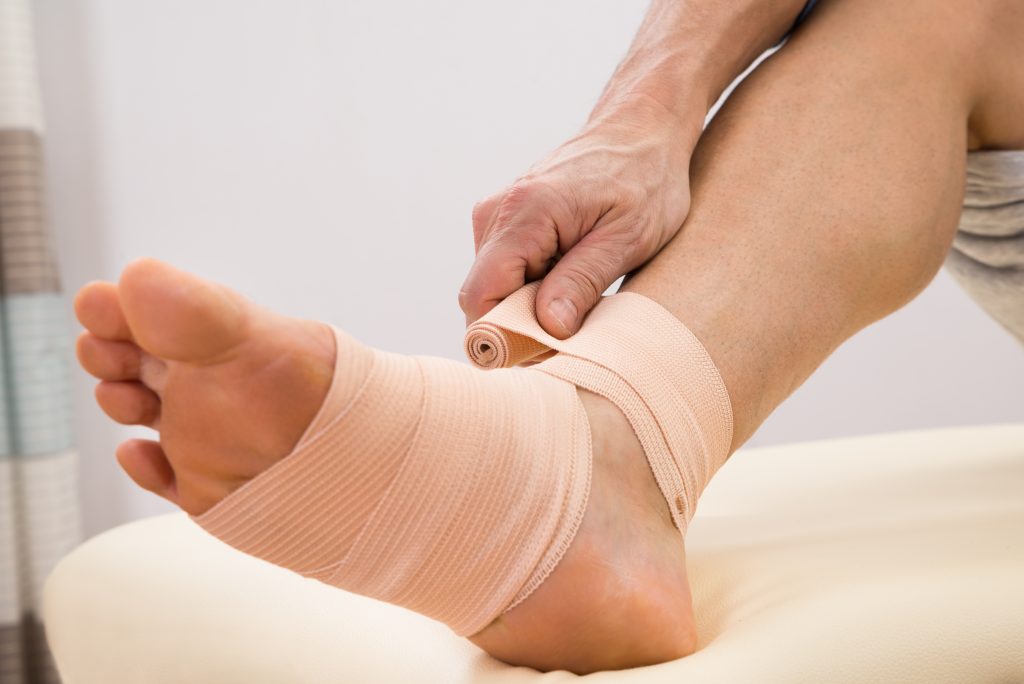June 10, 2022
Can You Walk On a Sprained Ankle?
A sprained ankle can cause lots of pain—especially when you try walking. Though staying off a sprained ankle can reduce your pain and help it heal, it can be nearly impossible to go about your usual daily activities without walking.
Here’s what you need to know about walking with a sprained ankle, how to wrap up a sprained ankle, and treatment options.
What Is a Sprained Ankle?
A sprained ankle occurs when you awkwardly twist your ankle. This injury can happen if you accidentally step in a hole or on something like a loose stone. It can also occur if you fall and land awkwardly on your foot.
When you suffer a sprain in your ankle, the tissues (ligaments) that hold your ankle bones together become stretched or torn. This is why walking becomes difficult and painful after an ankle sprain. Many times, your symptoms will persist until the ligaments in your ankle heal.
Should I Walk On a Sprained Ankle?
 While it is possible to walk on a sprained ankle, it isn’t recommended. Walking on a sprained ankle can delay the healing process and increase your risk for complications. Ankle pain, instability, and arthritis are common complications of a sprained ankle. These chronic conditions often require long-term treatment and can prevent you from engaging in your favorite sports and activities.
While it is possible to walk on a sprained ankle, it isn’t recommended. Walking on a sprained ankle can delay the healing process and increase your risk for complications. Ankle pain, instability, and arthritis are common complications of a sprained ankle. These chronic conditions often require long-term treatment and can prevent you from engaging in your favorite sports and activities.
After you sprain your ankle, you will need to stay off it as much as possible to allow it to heal fully. This may be frustrating at first, but it will benefit you more in the long run. Trying to push through the pain and resuming your activities can worsen the injury and delay its healing.
Can Walking On a Sprained Ankle Make It Worse?
Walking on a sprained ankle can definitely make it worse. However, your doctor will work closely with you to get you back on your feet following treatment. You may even be provided with a cane or crutches at first that help you stay off your injured foot.
Your doctor will show you how to walk with a sprained ankle in a way that will help you avoid pain and another injury. You may also be shown how to tape a sprained ankle, as well as exercises that can strengthen your ankle and help it heal. Though your doctor may teach you how to care for your sprained ankle, staying off it for a long period is the most effective way to recover.
What Are Treatment Options For a Sprained Ankle?
The RICE method is a common, effective treatment for an ankle sprain. RICE stands for Rest, Ice, Compression, and Elevate.
Resting involves avoiding activities that cause pain and swelling in the ankle, such as walking or driving a car. Icing involves applying an ice pack to the sprain for 15 to 20 minutes every two to three hours.
 Compression can help reduce swelling and pain caused by the sprain. Your doctor can show you how to use a compression wrap to wrap your ankle. Elevating involves raising your ankle above the level of your heart, such as by resting your foot on a mound of pillows while you watch television. This can help reduce swelling in the ankle by allowing fluid to drain back up your leg.
Compression can help reduce swelling and pain caused by the sprain. Your doctor can show you how to use a compression wrap to wrap your ankle. Elevating involves raising your ankle above the level of your heart, such as by resting your foot on a mound of pillows while you watch television. This can help reduce swelling in the ankle by allowing fluid to drain back up your leg.
Other treatments for a sprained ankle include medicines, devices, physical therapy, and surgery.
Over-the-counter medicines like ibuprofen and acetaminophen can reduce pain caused by the sprain. Devices like compression tape and a walking boot can help stabilize the sprain. Physical therapy can restore motion, strength, flexibility, and stability to your ankle. Surgery may be used as a last resort to repair or reconstruct a ligament that won’t heal.
Your doctor can discuss all your available treatment options for a sprained ankle during an appointment and work closely with you until it is completely healed.
How To Wrap An Ankle Sprain
Wrapping an ankle sprain can reduce swelling and allows the ligaments in your ankle to heal in a natural position.
Here’s how to correctly wrap an ankle sprain:
 Make sure you have a bandage that is long enough to wrap around your foot and ankle several times.
Make sure you have a bandage that is long enough to wrap around your foot and ankle several times.- Hold your ankle at a 90-degree angle.
- Wrap the bandage around the ball of your foot two times. The ball of your foot is where the toes meet your foot.
- Pull the bandage gently to keep it taut as you wrap it around your foot. Work upwards toward the ankle as you wrap. Wrap it diagonally from the bottom of your foot across the top, then around the ankle to make a figure-eight pattern.
- Wrap the bandage a few times around your lower leg, about two inches above the ankle. The bandage should cover the entire area from the ball of your foot to the heel and ankle.
- Use a fastener to secure the bandage in place.
When you’re done, the bandage should prevent your ankle and foot from moving freely but should not cause pain or discomfort. If you do feel any pain, remove the bandage and try wrapping it again. The compression wrap should feel snug without cutting off circulation to your foot.
How Long Does a Sprained Ankle Take To Heal?
The recovery time for a sprained ankle can last anywhere between a few weeks to several months. Your ankle can heal more quickly if you get plenty of rest and stay off the injured foot.
Factors that can affect the length of time it takes for a sprained ankle to heal include:
- The severity of the sprain
- The cause of the sprain
- Your age
- Your fitness level
- Nutrition
- Sleep
- Activity level
- The length of time that passed before you received treatment
Your doctor can give you a better idea of how long your ankle will take to heal based on these factors. Don’t hesitate to contact your doctor if you need extra help with taping your ankle or if other treatments aren’t working.
Treating a Sprained Ankle With Healthcare Associates Of Texas
Visit our website today to request an appointment if you need help treating a sprained ankle. Our board-certified physicians can perform an examination, treat your ankle, and help you get back on your feet as quickly as possible.
DISCLAIMER
The information featured in this site is general in nature. The site provides health information designed to complement your personal health management. It does not provide medical advice or health services and is not meant to replace professional advice or imply coverage of specific clinical services or products. The inclusion of links to other web sites does not imply any endorsement of the material on such websites.